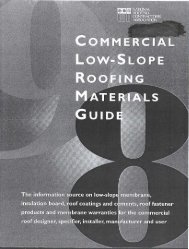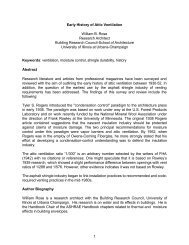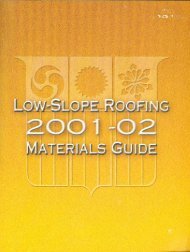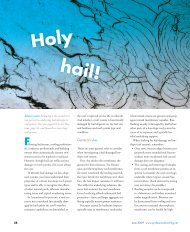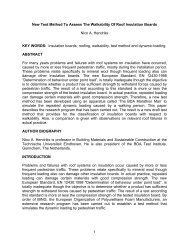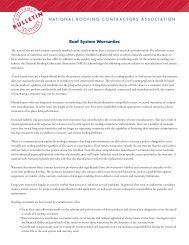Untitled - National Roofing Contractors Association
Untitled - National Roofing Contractors Association
Untitled - National Roofing Contractors Association
You also want an ePaper? Increase the reach of your titles
YUMPU automatically turns print PDFs into web optimized ePapers that Google loves.
Roof system vapor retarders generally fall into two<br />
classifications:<br />
1 . Bituminous membranes, in which a continuous<br />
film of bitumen serves as the vapor resistant element.<br />
A typical two-ply installation using three<br />
moppings of steep asphalt can provide a vapor<br />
retarder that is rated less than 0.005 perms.<br />
2 . Non-bituminous sheet systems, in which the<br />
sheet serves as the vapor retarder, and adhesive<br />
is used to seal the laps. These include POIC films,<br />
kraft paper and aluminum foil combinations, which<br />
may provide vapor retarders having permeability<br />
ratings ranging from 0.10 to 0.50 perms. POIC films<br />
and associated cold-applied adhesives are not<br />
recommended by NRCA because of their susceptibility<br />
to damage from other components in the<br />
system, such as the melting of vinyls by hot<br />
asphalt.<br />
Wherever vapor retarders are used. they should be constructed<br />
of materials compatible with other roof system<br />
components. It is recommended that the designer pay<br />
particular attention to flashing details at edge seals and<br />
at all penetrations through the vapor retarder in order to<br />
ensure the moisture-tight integrity of the vapor retarder.<br />
Vapor retarders can be easily punctured and damaged<br />
by foot traffic and mechanical equipment. These punctures<br />
must be carefully repaired prior to the installation<br />
of insulation, using a patch that is at least 12 inches larger<br />
in each direction than the puncture. In order to properly<br />
install and help prevent damage to a vapor retarder system,<br />
the laps must be made on solid bearing. For more<br />
specific information on vapor retarders. see Vapor Retarders<br />
in the Low-Slope section of the NRCA <strong>Roofing</strong> and<br />
Waterprooflng Manual.<br />
XI. LIGHTWEIGHT INSULATING<br />
CONCRETE DECKS<br />
Lightweight insulating concrete is used for the construction<br />
of composite structural decks and as a fill material<br />
over some structural decks. (It is not recommended for<br />
use, however, directly over poured-In-place or precast<br />
concrete decks.) The installation of lightweight insulating<br />
concrete requires large quantities of water, and some<br />
moisture will remain in the concrete even after the surface<br />
is dry. Venting must be provided to allow additional<br />
drying of the concrete and to prevent the buildup of water<br />
vapor pressure. Either topside venting or underside<br />
venting is advised on all lightweight insulating concrete<br />
decks. Topside, one-way venting in the field is preferable.<br />
Lightweight insulating concrete decks must have the following<br />
physical properties:<br />
. A minimum thickness of 2 inches of lightweight<br />
concrete<br />
. A minimum dry density of 22 pounds per cubic<br />
foot (pcf), or a dry density capable of providing a<br />
fastener withdrawal resistance of 40 pounds per<br />
fastener<br />
. A minimum compressive strength of 125 pounds<br />
per square inch (pSt")<br />
Lightweight insulating concrete decf




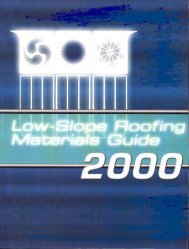
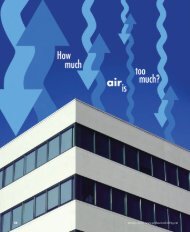

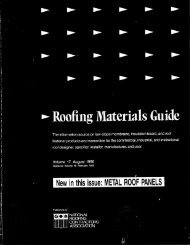
![Wm] - National Roofing Contractors Association](https://img.yumpu.com/36696816/1/190x245/wm-national-roofing-contractors-association.jpg?quality=85)

